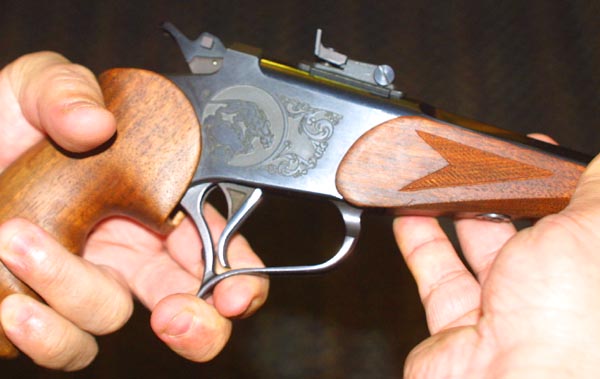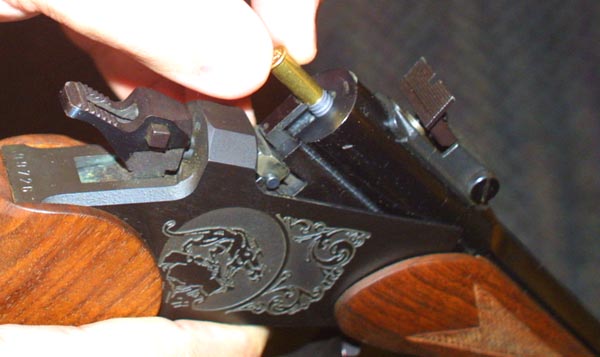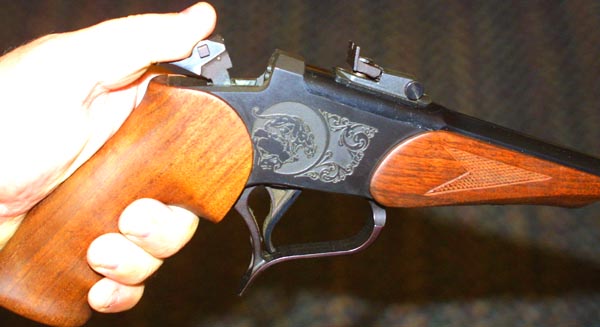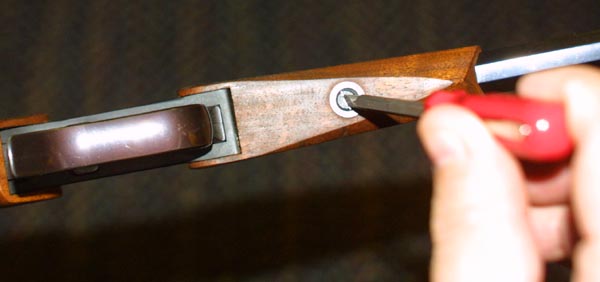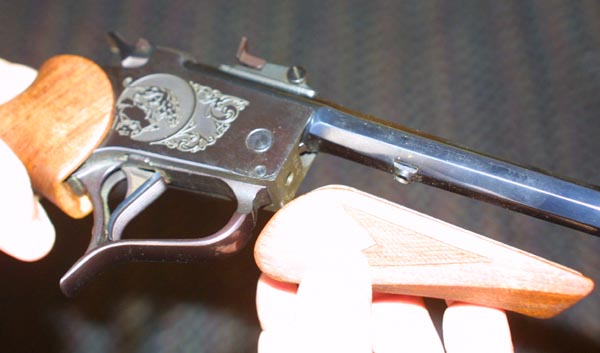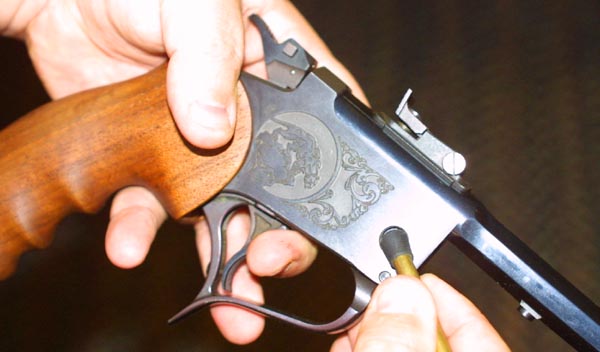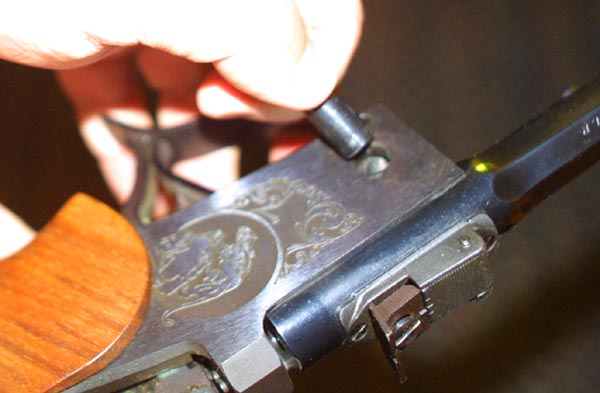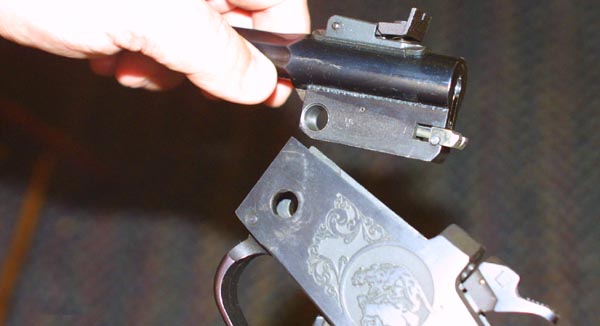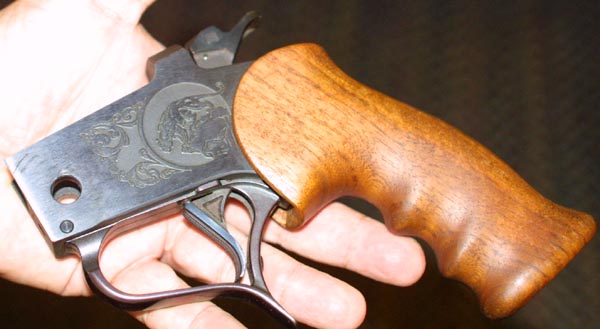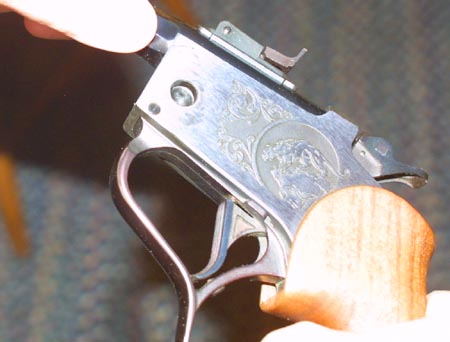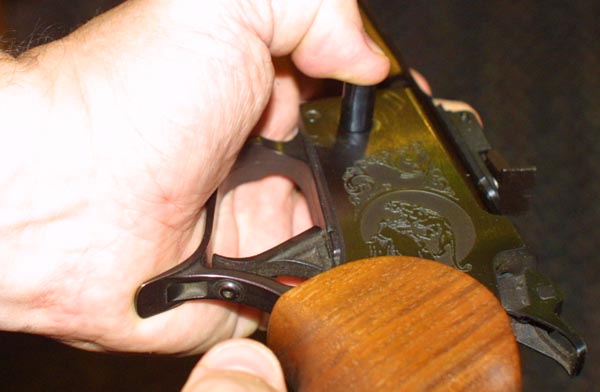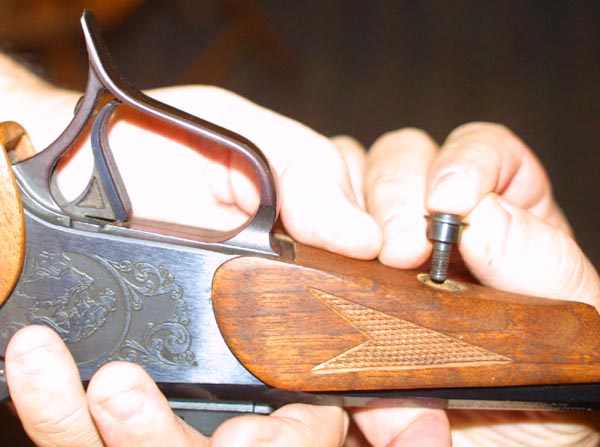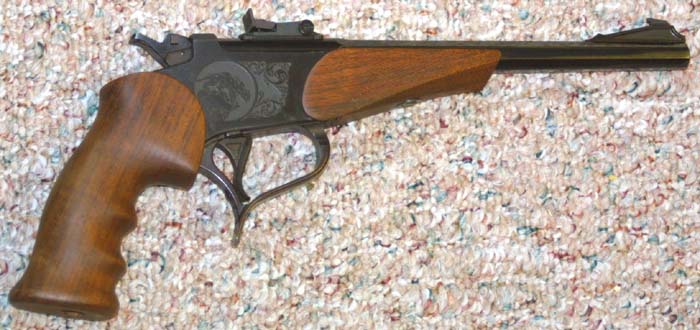 Contender (shown with 10" .357
bbl.)
Contender (shown with 10" .357
bbl.)
 Where this gun is in it's element is with a stalking hunter who moves
in close to his quarry, and considers the stalk to be the hunt. The gun
is small, has but a single shot, and like all pistols, is much more difficult
to shoot than a rifle. My particular model generally has a .45 L.C./ .410
shotgun barrel on it. For any one who has not fired a shotgun shell out of
a pistol barrel, the experience is a bit intense. You load the gun by pulling
back on the trigger guard which permits the barrel to be tipped up. After
loading the single cartridge, the hammer is pulled back and the gun is fired.
It is very common to see scopes on these guns in some of the rifle calibers
for which they are chambered. A line of slings and specially made holsters
are available, as well as barrels from custom manufacturers in a number of
wildcat calibers. I presently have barrels in 45/410, .357 Magnum, .44 Magnum,
.22lr, .223, and 30-30. I plan to get a barrel in .35 Remington to round things
out. I am also considering purchasing a 45-70 barrel.
Where this gun is in it's element is with a stalking hunter who moves
in close to his quarry, and considers the stalk to be the hunt. The gun
is small, has but a single shot, and like all pistols, is much more difficult
to shoot than a rifle. My particular model generally has a .45 L.C./ .410
shotgun barrel on it. For any one who has not fired a shotgun shell out of
a pistol barrel, the experience is a bit intense. You load the gun by pulling
back on the trigger guard which permits the barrel to be tipped up. After
loading the single cartridge, the hammer is pulled back and the gun is fired.
It is very common to see scopes on these guns in some of the rifle calibers
for which they are chambered. A line of slings and specially made holsters
are available, as well as barrels from custom manufacturers in a number of
wildcat calibers. I presently have barrels in 45/410, .357 Magnum, .44 Magnum,
.22lr, .223, and 30-30. I plan to get a barrel in .35 Remington to round things
out. I am also considering purchasing a 45-70 barrel. The .357 barrel, and the .44 barrel, both have removable tips which act as chokes. They are also both ported, to reduce perceived recoil. The chokes have a 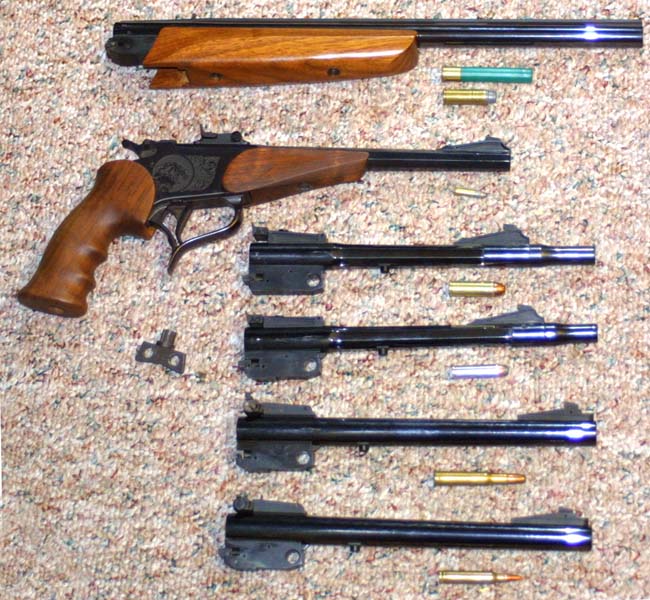
The standard gun is available in blue or stainless, and the barrels may be mixed on the frames. The exception to this is the now discontinued armalloy frames and barrels which must be modified somewhat to fit. There are also some problems with the use of some early barrels on some of the latter frames. The problem centers around the size of the pin holding the barrel in, which is fractionally larger on the newer frames. The frame can be modified, or the barrel mount can be reamed out. The standard, single screw, forearm is for use with barrels up to 10" long; there are separate models for standard, bull, and octagon barrels. A larger, two screw, forend is available for the 14" to 16" barrels. I own the traditional framed version, though a newer, improved version of the gun is now made. The newer model Thompson (the Encore) is of a different design, and the barrels will not interchange, and there is no practical modification to make them do so. There is a special feature to the 45 L.C. barrel, and to some of the magnum handgun caliber barrels. This is the removable choke. The feature was introduced on the octagon barrels, as a way to fire a newly introduced shot shell cartridge. These cartridges were called Hotshot shells, by Thompson, and were pistol cartridges, loaded with shot capsules. The thompson cartridges were not the first pistol rounds to be so designed; but there was a difference. A Hotshot capsule was quite a bit longer than an ordinary shot capsule, and took advantage of the Contender's single shot action, which allowed for the chambering of such long cartridges. These shells could not be used in ordinary handguns, because of their length. The Hotshot shell is no longer in production; but CCI and others, still manufacture pistol caliber shot she The chokes actually perform a couple of functions. Though they do affect the size of the shot pattern, the main function is to counteract the effect of the barrel rifling. All of the Contender barrels are rifled. This is both to insure accuracy, when used with standard cartridges, and to conform to the law. The problem with this, when firing shot capsules, is that spinning a shot capsule will destroy any chance of having a decent shot pattern. So the chokes, of these barrels are fluted to channel the shot, and to prevent it from being spun out of the barrel. Needless to say, such a barrel is not suitable for the use of standard cartridges. To address this issue, allowing the use of standard cartridges, Thompson made these chokes removable. A small wrench, which looks a bit like a winding key to a clock, is included. The wrench fits into the flutes at the muzzle end of the choke, and is used to unscrew it from the barrel. In addition to the screw in chokes, the old octagon barrels also have gas ports at the muzzle, to aid in recoil management. Other than the "fun" factor, there is not much to recommend the use of shot shells in handguns. The amount of shot held in a standard sized pistol cartridge is too small to really be of much use, except at very short range. The Hotshot capsules partially remedied this. With their extra long shot capsules, they could be pretty close to the 410 shotshell in power and shot capacity; but they are no longer made, and were only usable in the Contender. This brings us to the use of an actual shot shell, the 410, in a handgun. This is a whole different story. Unlike the old Hotshot shells, the 410 is a standard gauge shell, widely produced, widely available, and inexpensive. In recent years, the Contender, having set the precedent, has been joined by a few other handguns, chambered for the 410. The first was a little double derringer, made initially by Cobray; but eventually produced in kit form, and by several manufacturers. There was also a high quality derringer made by Bond Arms, and probably some others. Then there was the Thunder Five, which was a semi custom, five shot revolver. Most recently, there was the introduction of a five shot 410 revolver, by Taurus, based upon a stretched version of their standard double action revolver frame. Further production of all of these arms, is endangered by a proposal from the democrats, to outlaw, what they are calling "Hand held shotguns". This may negatively impact the Contender, in several ways. Should this initiative succeed, there may then be a call to ban hand held rifles, and we will see the end to the long range hunting pistols, such as the Contenders chambered for rifle cartridges. Time will tell. Political, and legal arguments aside, this is the most accurate long range handgun in the world. Of course this point is open to argument from those who consider the Contender to be more akin to a rifle than a pistol. Even among these people, however, there is no argument that there is not a pistol made, that is capable of out shooting a Thompson Contender, particularly when topped by a barrel chambered for a rifle cartridge. The long range is a result of chambering these guns for rifle calibers, and using super strong barrels so that even in pistol chamberings, very potent loads may be used. The accuracy is the result of the heavy barrels, and also of the simple, strong action. These are single shot pistols with no recoiling, rotating, reciprocating, or sliding parts, once the arm is fired. The only parts to move during the firing of the weapon are the hammer and the firing pin. To top it all off, the trigger is superb, very light and crisp, with very little travel. The locking of the barrel/chamber with the frame of the gun is positive and secure. With the exception of it's lack of firepower (1 shot only), this is as near an ideal gun as I have ever seen. The single shot limitation has become a matter of pride to Contender enthusiasts. They consider themselves to be precision shooters, for whom the use of a single shot is not a handicap. ONE SHOT; ONE HIT.
Loading and firing
The Contender, as a single shot firearm, has no magazine,
or cylinder to load. A single round is loaded, by pulling back on the trigger
guard, to break the action open.
Changing the barrel Besides it's unarguable accuracy, and the unmatched strength of it's action, the Contender is prized for it's ability to be easily converted to fire a variety of cartridges, including a number of rifle rounds.
|
||||||||||||||||||||||||||||||||||||||||||||||||||||||||||||||||||||||||
